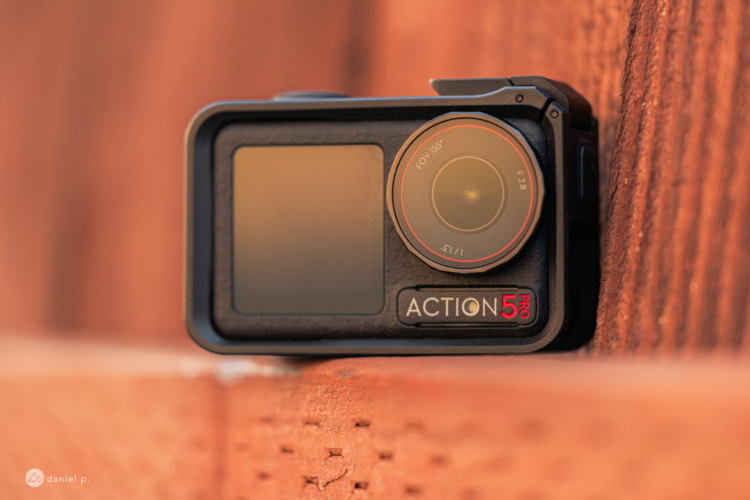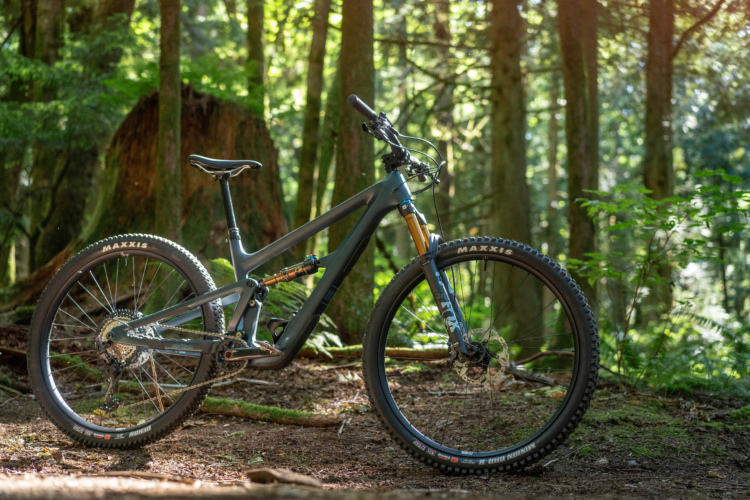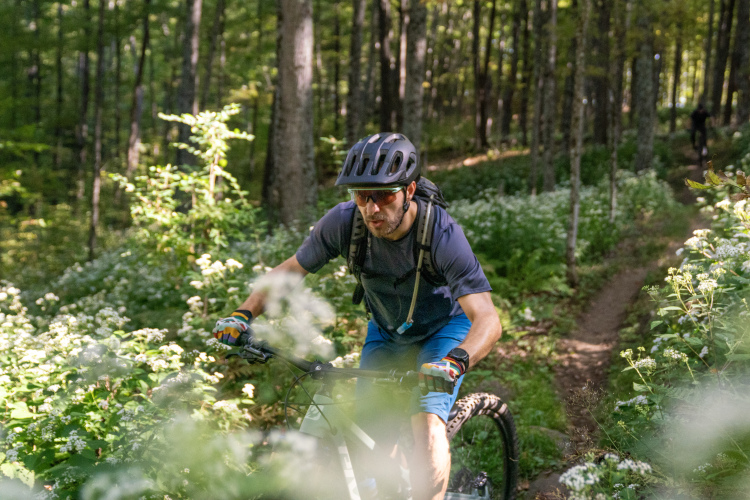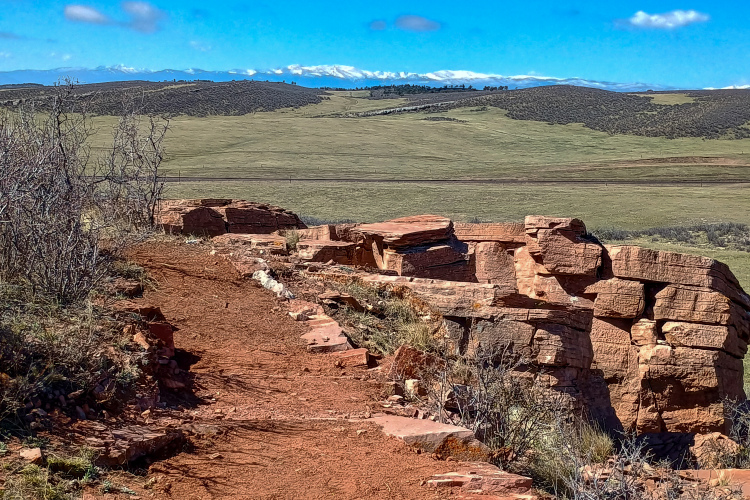
Action camera companies are packing more and more features into these tiny cameras, and over the years I have owned GoPro, DJI, and Insta360 products, many of which I bought myself. I have looked through all the marketing videos, ads, and descriptions trying to find the “best” action camera for mountain biking and other outdoor adventures. All I ever want out of an action camera is for it to record well in both bright and low-light environments, stabilize the shaking that comes from mountain biking, and offer good clear audio at a “reasonable” price. Those are my bare minimum requirements. Anything extra is well appreciated.
I recently got the chance to test out the new Insta360 Ace Pro 2 action camera, and in this review I’ll cover the key specs and share how it performs for mountain biking.
Insta360 Ace Pro 2 specs
Right out-of-the box, I noticed the Ace Pro 2 has a heft to it. The camera feels a bit chunkier and heavier than the GoPro and DJI action cameras I’ve used. My sample weighs 178g with the battery inside compared to 145g for the DJI Osmo Action 5 Pro I recently reviewed. That’s also more than the Insta360 ONE RS camera, which weighs about 135g with the 360° lens. The Ace Pro is not the lightest in its category, but the overall size is almost on par with most action cameras in this category, meaning it still fits in the palm of my hand and can be thrown in any pocket.
The Insta360 Ace Pro 2 has a tough outer shell that should withstand bumps and drops, and this model now features a removable and replaceable front lens guard for extra protection.

Flip touchscreen
One of the stand-out features of Insta360 Ace camera lineup is the flip touchscreen, which allows for optimal viewing angles. For version two, the screen is a bit larger and got a bump in resolution. As a long-time professional photographer, flip screens are a game changer when shooting. I know other companies are putting secondary screens at the front of the camera, but having the large main screen flip a full 180 degrees has its advantages. Whether you are V-logging or getting B-roll of your new bike, the flip screen makes it easier to get better footage.




The Ace Pro 2 also has a small, low power reflective LCD screen on the front. The non-touch screen is backlit and bright. It shows the current shooting mode and settings. I actually like this as I have used professional cameras with one main flip screen and one small LCD screen similar to the Ace Pro 2. I didn’t really find the need for a small full color touch screen up front.

Microphone
Audio quality can be as important as video quality. If you have ever watched raw mountain bike POV footage, you should be familiar with wind noise, especially if the rider is rocketing through the trails on a windy day. Wind noise is pretty much unavoidable, and it can ruin your content. Action camera companies have tried to improve this by adding multiple microphones to their cameras or using software wizardry to reduce wind noise.
That’s all fine and dandy, but Insta360 figured that many content creators were placing wind guards over their microphones to reduce or remove wind noise entirely. This method has been around in the audio industry for many years. Insta360 added a replaceable wind-guard in front of the microphone that is so sleek, you can barely notice it’s there. What is noticeable is the drastic difference it makes in audio quality and clarity. Such a simple thing can make a big difference.

Battery
The Ace Pro 2 operates using a now bigger capacity 1800mAh battery, which promises up to three hours of recording time. This battery can be quickly charged to 80% in about 18 minutes and 100% in about 47 minutes using the included USB-C cable. No power brick is included in the box, but any USB-C changing brick will work. If you want that fast charging, use a PD fast charger.
I never keep my action camera continuously recording; instead, I typically just hit the record button on the downhill sections of my ride. I doubt anyone wants to see me huff and puff during the climbs. That being said, a fully charged battery lasted through my three-hour bike ride around the local trails. That translated to about five, two-minute-long 8K videos and five, two-minute, 4K videos while messing with settings and viewing some footage on the screen. I had about 20% left on the battery capacity once I got back in my car. Three hours is my average bike ride, and the Ace Pro 2 kept up. I did have the extra battery in my bag just in case, but I didn’t need it. I did notice the most battery percentage drop when recording in 8K, so if your plan is to record in 8K all the time, you can always buy more batteries a la cart if necessary.
At any point during your ride, you can activate the new Endurance Mode which will allow you to record in 4K 30fps and 1080p 24fps with a 50% longer runtime, at the cost of disabling other features like Active HDR. I had no need to enable Endurance Mode but I can imagine it might come in handy when carrying only one battery.
An interesting thing to mention is that this action camera has a reverse-charge feature. I was able to charge my iPhone using the USB-C to USB-C cable the camera came with. That was pretty neat! Not sure how often I would use this feature, but it could come in handy in a pinch.
Hardware
The Insta360 Ace Pro 2 is pushing action camera capabilities with its upgraded 1/1.3” 8K sensor and Leica Summarit Lens. This new sensor supports 13.5 stops of dynamic range. Having that wide range of stops of light is beneficial in low light scenarios, especially for a small, pocketable camera. This proved especially beneficial when recording on tree-shaded trails as the sun was setting.

A good camera should always have a good image sensor and a good lens. Insta360 has been teaming up with the globally known camera company, Leica, to co-engineer high quality lenses for some of their action cameras. The Ace Pro 2 has a Leica lens that offers optimal clarity and allows as much light as possible to pass through to the image sensor. That 8K sensor is hungry for light!
To help process all that light data, Insta360 uses two processing chips to do the hard work. Tasks are now divided between the two chips for better processing efficiency. The “AI Chip” will process all the textures and details of the environment even during low light. At the same time, the new “Pro imaging Chip” processes noise reduction and image processing to give you the best images captured by the lens and image sensor.
No built-in memory
I’m a little disappointed the Ace Pro 2 doesn’t include built-in memory. It is good to mention that the standard bundle does not include a micro SD card either. DJI, by comparison, throws in 64GB of built-in storage to get folks rolling. This 8K camera needs a lot of storage to hold that high resolution footage; a four minute clip recorded in 8K at 30 fps eats up about 4.5GB of storage. I used a 256GB micro SD card because a smaller memory card could get full quickly if you don’t dump the footage onto a hard drive. In my opinion, some built-in memory in the Ace Pro 2 would have been the cherry on top.

On the trail: User-friendly interface and controls
I really like the user interface. The touch screen is very responsive and accurate when tapping on the small icons. There are many modes to choose from. You have your Video, PureVideo, Slow Motion, FreeFrame Video, TimeShift, Timelapse, Starlapse, Dashcam, Loop Recording, Slow Motion, Photo, Burst Photo, and Interval Photo.
At first, the number of modes to swipe through was a bit irritating, but found it’s possible to create custom presets for your most-used modes and settings, or you can choose the provided action sports presets. There are presets for biking, diving, skiing, surfing, and even vlogging. The biking preset selects the very best setting in 4K resolution.
The user interface never lagged or froze on me. It doesn’t always recognize touch with gloves on, but, it seems that many touch screens don’t get along with gloves.
The camera settings are easy to get to for toggling through certain functions. There is even taptic feedback through a built- in taptic engine which will vibrate in different frequencies. When the camera is mounted on my helmet, it buzzes the helmet every time I hit that record button. This was a feature I didn’t know I wanted! Neat! Overall, I like the Insta360 user interface thanks to its easy learning curve.




There are only two external buttons on the camera: a power button and a record button. Both do their job, but I wish they were a bit bigger. I felt I had to press the buttons a bit harder than other action cameras. On the plus side, there is a voice command feature, which I used a few times and found it worked well. I recommend trying the voice commands so you don’t have to fiddle with the buttons while riding your bike. After pressing record, I did notice a tiny delay of about 3 seconds for recording to start compared to the DJI Action 5 Pro camera that I tested, which starts recording almost instantly.
The Ace Pro 2 uses a magnetic quick release system to mount and un-mount the camera from its accessories. While I do like this system for quick changing, I had to fiddle with the included plastic magnetic mount when mounting and removing it from my helmet visor. I feel like Insta360 could have used stronger magnets for better alignment, like the DJI Action 5 Pro uses. I also tried the Insta360 alloy magnetic quick release accessory, which was much better at aligning and attaching.

Advanced imaging capabilities
I rode some local trails and recorded in various modes to see what the Ace Pro 2 is all about. Insta360 advertises its 8K capability, so I gave that a try. When recording in 8K, I was restricted to only 30fps and “standard” stabilization. I rode a familiar trail that is very shaded with some sun-exposed sections. When I played the footage back, I noticed extra details in the foliage, good low-light performance, and okay stabilization while on my chesty mount. In 8K mode I could not record with Active HDR, and could really notice those bright, sun-exposed “hot spots”. 8K recording doesn’t allow ActionView either, which provides a wider field of view. Now, while you can get usable footage while out riding and recording in 8K, it just doesn’t record POV footage as well as the 4K settings. I also noticed the camera getting warm when recording in 8K, but it never forced a shutdown. If you really want to record in 8K, mount the camera to a helmet visor mount, and try to record on more open, sun-lit trails if possible.
I would say 4K at 60fps with active HDR is the new recording standard for action cameras. This is what most folks will be using to get the best image clarity along with the best image stabilization. When selecting 4K resolution and 60fps, I was able to turn on Active HDR, High Stabilization, and access ActionView. These were the perfect settings to record MTB POV footage in just about any trail conditions. The footage looks smooth, stable, and the active HDR is really noticeable. Even in low light, the camera did an excellent job balancing the footage when in and out of shaded areas. YouTube compresses uploaded videos, so you may not see the best quality that I am talking about. I uploaded a 4K 60FPS video with Active HDR, High Stabilization, Action View, and edited using the Insta360 App at the maxed out quality settings.
PureVideo
Pure Video is intended to be used in really low light situations. It did a good job recording a trail run right after sunset. The trail was pretty dark so I was shocked at how well the camera performed. Now you can see how it struggled with the little light that was available. I used High Stabilization mode, which I think helped make the footage look better. While I don’t think Pure Video mode is optimized for mountain biking, the footage is pretty usable allowing for sunrise to sunset video recording.
Stabilization
The Stabilization software is great when used in the “High” setting. I wouldn’t really use the “Standard” setting for a mountain bike video unless you are just cruising flow trails. Although the High setting does crop into the 157° wide-angle field of view, the Action View option still captures plenty of what’s ahead.

Editing and sharing
After recording some footage, it’s easy to view what you captured using your smartphone. The connection between the camera and my iPhone 16 Pro Max was steady throughout and file transfers were fast, which makes for a smooth workflow. On the app, there are many options to create and edit your footage. You can find many presets, styles, and even a feature called AI Warp.
AI Warp will run a clip of your video through AI-based cloud servers, to then deliver a short AI rendering of that same video. AI is doing crazy things!
Now, while I was able to watch my 8K video on the iPhone app, it did not allow me to transfer and edit the footage. Even with the app performance option toggled on, I think the file was just too big to transfer over Wi-Fi. This is something to keep in mind if you plan on recording and editing in 8K resolution most of the time. However, you can use the Insta360 app for Mac and Windows computers to transfer and edit your content. Thumbs up for this app, as I am constantly editing content on my computer.



Practical accessories and versatile mounting options
The Insta360 Ace Pro 2 works with standard two-pronge action camera mounts. This means you can use just about any accessory that has a corresponding three-prong mount.
I got the chance to try the Multi-Mount Tripod/Selfie stick that compactly folds for easy storage. I also tried their utility metal full body frame with cold shoe mounts on both sides for use with an external microphone and external light. The metal quick release mount with foldable prongs is unique and compact. For vertical shooting, the Vertical-Horizontal L-bracket Mount is very handy. All the accessories that I tried worked flawlessly with each other. If you want to fully accessorize, check out Insta360’s large list of options here.

Pros and cons of the Insta360 Ace Pro 2
Pros
- Excellent low-light performance
- Wind cover offers clear audio when mountain biking
- Flip up screen
Cons
- 8K footage takes up large amounts of memory
- No internal storage built-in
- Heavy
Bottom line
So, does the new Insta360 Ace Pro 2 camera deliver for mountain biking? The answer is yes. The camera performs exceptionally well in low-light environments, such as tree-shaded sections of the trail. I was shocked that the footage it recorded at sundown was so good for the little amount of light available. The stabilization it offers is great for mountain biking, but only in the high setting. I rolled through rooted sections, brake bumps, and even hit some jumps, and the camera kept the footage steady. The audio is outstanding, especially with the new wind cover they have integrated into the design. There is drastically less wind noise in the footage, allowing for more tire, rear hub, and sounds from the surrounding environment. The mic picks up on voices clearly, so if you love to talk to your audience as you ride, this will be a favorite feature. You can even isolate your voice in the Insta360 app, so that only your voice can be heard.
Over the last couple of years, we have seen action camera prices drop a bit. This new Ace Pro 2 costs $419.99 retail, which is comparable to the new GoPro Hero 13 Black. The new DJI Action 5 Pro is priced a bit lower at $350, and I would have loved to see the Ace Pro 2 sit at the $350 USD mark for the standard combo. All its flagship features come with a bit of weight penalty, and although the Ace Pro 2 does offer features that other cameras don’t, ultimately, it will be up to you what you want to get out of your action camera.
The Insta360 Ace Pro 2 checks off my boxes with some of the sharpest resolution I’ve found and offers a fun and easy-to-learn user interface to turn users into great content creators.











1 Comments
Nov 11, 2024